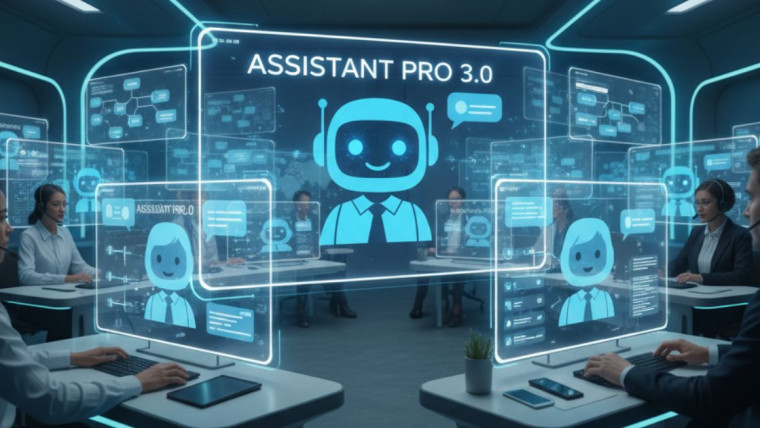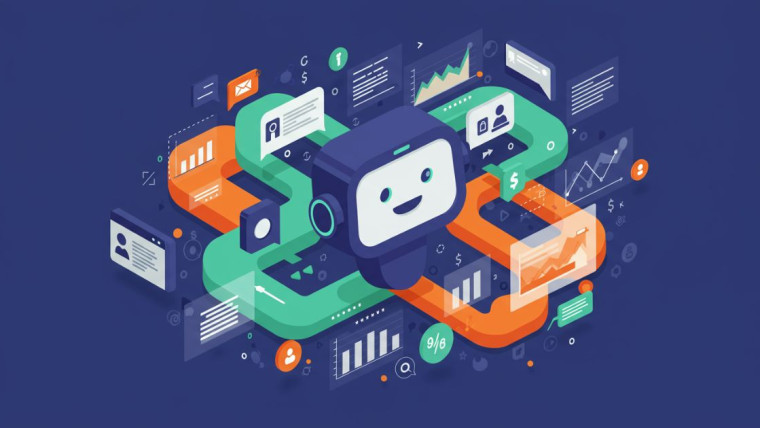Voice-driven chatbots are transforming the way businesses interact with their customers. These artificial intelligence chat assistants can even comprehend human speech and respond naturally in conversations. It’s now more common for businesses to have voice chatbots to enhance the customer experience and provide a more natural user experience.
This guide will get you up to speed on voice-activated chatbots. You will discover how they function, what they’re good for, and how you can apply them in your business.
What Are Voice-Activated Chatbots?
Voice-activated chatbots are chatbots powered by AI that can understand and communicate in human language. These are not the traditional text chatbots of the past, where users’ spoken language is processed through a voice recognition system.
When a person talks to a voice chatbot, a number of things happen rapidly:
-
The sound input is also taken by the system
-
Speech recognition translates the audio into text
-
Natural language processing can even comprehend the sense
-
AI produces the response that should have occurred
-
Text-to-speech technology delivers the answer
These conversational AI products continue to improve every year. They can respond to complex requests, recall previous conversations and emotions in language.
Key Components of Voice Chatbots

Speech Recognition
It is the technology that can translate spoken words into text, which can then be read by computers. In contemporary systems, accuracy exceeds 95% in question-sensitive conditions.
Natural Language Processing (NLP)
With NLP, chatbots can recognize the meaning of words. It accounts for context, intent, or even slang or casual language.
Machine Learning
The more you chat, the smarter the AI assistants get. They get better at responding over time and they get better at helping users.
Text-to-Speech
Its task is to translate the responses of the chatbot in an L2 word into human-like speech. Better systems can even replicate the speaker’s manner of speaking.
Benefits of Voice-Activated Chatbots

Voice-Enabled Chatbots vs Traditional Customer Support
Voice chatbots outperform traditional customer support in numerous ways. This is what makes them appealing to businesses, regardless of size.
Improved Customer Experience
The voice interaction is more natural than typing. Customers can talk at their normal speed and without worrying about spelling or grammar. This makes the experience all the more comfortable.
Voice chatbots can also multitask. Users can use their voice while engaging in other activities, which is convenient for seeking assistance without interruption.
24/7 Availability
Unlike their human counterparts, voice-activated chatbots never take a break. Customers can get assistance 24/7, including holidays and late nights. This always-on capability leads to better customer satisfaction.
Cost Reduction
Voice chatbots AI can take many of these routine queries out of human hands. This alleviates pressure on customer support teams and reduces operational costs.
One voice chatbot can handle hundreds of chats simultaneously. This is scalable and cost-effective for businesses with high customer service volumes.
Faster Response Times
Voice chatbots provide prompt answers to customers’ inquiries. And there is no wait for an agent to become available. Faster answers lead to better customer satisfaction and less frustration.
Data Collection and Analysis
Each voice chatbot conversation yields lots of useful data. From this information, businesses can ramp up to provide what customers need and/or address issues during production.
Types of Voice Chatbots
There are various types of voice chatbots with distinct use cases. Knowing which categories your business falls into gives you the ability to select the right solution for your business.
Rule-Based Voice Chatbots
These chatbots are based on a set of pre-written rules and scripts. They function just fine for getting predictable, simple information, but fail to deal with the complexity that is new, said Vasin and Viyabura.
It’s much simpler to build and maintain rule-based systems. They are well-suited for businesses with straightforward customer service requirements.
AI-Powered Voice Chatbots
These are next-generation systems based on machine learning and natural language processing. They can engage in complex conversations, learn from their environment, and adapt to various circumstances.
AI chatbots require more development but offer a better customer experience. They are ideal for businesses with varying customer service needs.
Hybrid Voice Chatbots
Hybrids are systems employing elements of rule-based and AI techniques. They employ rules for common situations and AI for complicated ones. This equilibrium is a trade-off between reliability and flexibility.
Voice Chatbot Use Cases

Voice-activated chatbots are ideal in several business scenarios. The following are the most popular applications:
Customer Service
Voice chatbots powered by AI can efficiently handle repetitive customer requests, such as verifying the current status of an order, providing product details, or managing returns. They allow human agents to focus on more complicated problems.
E-commerce Support
Internet retailers deploy voice chatbots to assist customers with sifting through and comparing products, as well as making the purchase. Shopping via voice is more convenient, especially on mobile.
Healthcare Services
Hospitals also employ voice chatbot AI to help schedule appointments, send medication reminders and answer commonplace health queries. They are one way to streamline administrative burden and bolster patient care.
Banking and Finance
Voice chatbots are utilized by banks for checking account balances, reviewing transaction history, and providing day-to-day banking services. These are secure and convenient systems for managing financial information.
Educational Support
For schools and training institutions, Voice chatbots are provided to support students, addressing queries, course details, and learning support. They are there to help students succeed, 24/7.
Choosing a Voice Chatbot Platform That Works Best for You
Platform selection is crucial for the success of voice chatbots. Things you may want to consider before making a choice:
Technical Capabilities
Look for platforms that offer:
-
High-quality speech recognition
-
Advanced natural language processing
-
Multiple language support
-
Integration with existing systems
-
Scalability options
Ease of Use
Choose platforms with user-friendly interfaces. You have to be able to create and customize chatbots without technical expertise.
Customization Options
Your voice chatbot should convey the personality of your brand. Search for platforms that enable voice, tone and conversation style to be tailored.
Analytics and Reporting
Great platforms offer rich analytics about how your chatbot is working. This information helps you better understand customer interactions and how you’re performing.
Cost Structure
However, you should also consider the costs over time. With some platforms, you pay per conversation, while others charge a monthly subscription. Select a model that suits your budget and usage requirements.
Implementation Best Practices
By following best practices, you safeguard the success of your voice chatbot project. They will prevent you from falling into the most common traps and spending efforts that won’t pay off.
Define Clear Objectives
Begin by deciding what you want your voice chatbot to do. Concise goals inform design decisions and provide a benchmark for success.
Common objectives include:
-
Reducing customer service costs
-
Improving response times
-
Increasing customer satisfaction
-
Handling routine inquiries
-
Collecting customer feedback
Design Natural Conversations
The voice should be conversational, akin to speaking to a helpful individual rather than a robot. Write using the language of conversation and spare the jargon.
Plan for different conversation paths. Users can ask questions using different wording, and your chatbot needs to comprehend a variety of phrasings.
Test Thoroughly
Test your human voice chatbot in the wild prelaunch. Collect feedback regarding the flow of conversation, the accuracy of the response, and the overall experience.
Take into account various accents, rates of speech, and noise levels. Your bot should easily interface with different worlds.
Provide Human Escalation
Even the most proficient voice chatbots struggle in certain situations. With that, ensure that your users are always presented with a way to reach out to an agent, a real human being if necessary.
Easily escalate and keep the conversation in context. Users should never need to duplicate information that has already been provided.
Monitor Performance
Track key metrics like:
-
Conversation completion rates
-
User satisfaction scores
-
Response accuracy
-
Average conversation length
-
Common failure points
Leverage this knowledge to optimize the performance of your voice chatbot.
Challenges and Solutions
Voice-activated chatbots face several challenges. Recognizing these challenges helps you craft effective solutions.
Speech Recognition Accuracy
Background sounds, different accents and pronunciation styles are all challenges that can impact the accuracy of recognition. Select systems with robust noise cancellation and diverse training data.
Perhaps providing a text alternative for those who prefer to type or have difficulty speaking.
Privacy and Security
Voice data contains sensitive information. Take all necessary security precautions and comply with relevant privacy regulations, such as GDPR and CCPA.
Be clear about how you collect and use data. Offer transparent privacy policies and opt-out choices.
Integration Complexity
Integrating voice chatbots with backend systems can be difficult. Hire more experienced developers or opt for frameworks with built-in connections.
Integrate your plan with great care, and test everything to death before you go live.
User Adoption
Not all customers may be comfortable with voice chatbot AI. Making the directions clear and showing the results of positive experiences.
Provide training resources and guidance to help people get comfortable with new voice interactions.
Voice Chatbot Technology Trends of the Future
Voice chatbot tech continues to advance at a breakneck pace. These are going to be the driving forces behind the future of conversational AI:
Improved Natural Language Understanding
Voice chatbots of the future will be more contextually aware, emotionally intelligent and intention-based. They will deliver more sophisticated conversations and give us more personalized responses.
Multimodal Interactions
Voice and visuals together in next-gen chatbots. People could talk face-to-face while looking at charts, pictures, or videos for more in-depth conversations.
Emotional Intelligence
Next-gen AI assistants will feel your tone and get depressed when you’re snippy. This will allow better, more empathetic customer service.
Integration with IoT Devices
Voice chatbots will integrate with smart home and wearable breaking other IoT systems. This will enable the integrated approach to be delivered consistently across various touchpoints.
Getting Started with Voice Chatbots
Need to get started with voice-activated chatbots for your business? Here’s how to get started:
Step 1: Assess Your Needs
Assess your current customer service issues and where your voice chatbot can fit in. Consider your audience, the common questions they may have, and the resources you have readily available.
Step 2: Choose a Platform
Explore the numerous voice chatbot platforms and select one that meets your requirements and budget. Take into account usability, features, and quality of support.
Step 3: Design Your Chatbot
Develop chat flows that can respond to your most common questions from customers. Keep it natural and offer clear signs on where to navigate.
Step 4: Test and Refine
Test it thoroughly with real users and collect their feedback. Leverage this insight to optimize how your chatbot responds and the path of the conversation.
Step 5: Launch and Monitor
Put your voice chatbot ai into action and track it extensively. Monitor core metrics and user feedback to inform the next iteration of the product.
Maximizing Your Voice Chatbot Investment
Voice-controlled chatbots present a significant opportunity for businesses to deliver improved customer service at a lower cost. If properly planned, implemented, and improved, success is returned.
Start with a clear goal and choose the platform that best suits your needs. Create authentic conversations that actually add value to your customers. Test, test, test, and be ready to iterate based on user feedback.
Keep in mind that voice chatbots are augmenting human abilities, not replacing humans completely. The most successful use of A.I. is for efficiency, but humans for humane complexity.
As conversational AI technology continues to advance, early adopters will gain a competitive edge over others. Is now the right time to think about what a voice-activated chatbot can do for your customer experience?
Tempted to use voice chatbots in your business? Begin by defining your top customer service use cases, and then see which platforms can meet your needs. The next phase of customer engagement is through voice Chatbots AI, and your customers are ready to talk.








Chatbots for Customer Retention: How AI Improves Loyalty and Reduces Churn
Transforming Employee Onboarding with AI Chatbots: A Step-by-Step Guide
Emergency Response Chatbots: Revolutionizing Crisis Management with AI
Revolutionizing Recruitment: How Chatbots Streamline Hiring Processes and Elevate Talent Acquisition